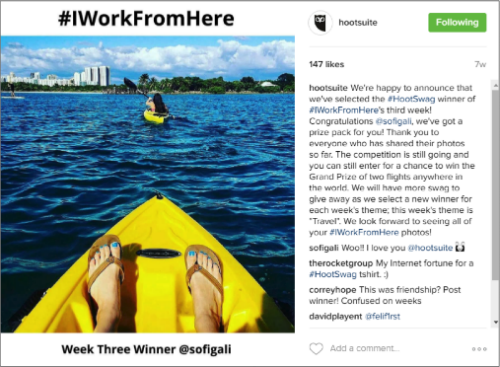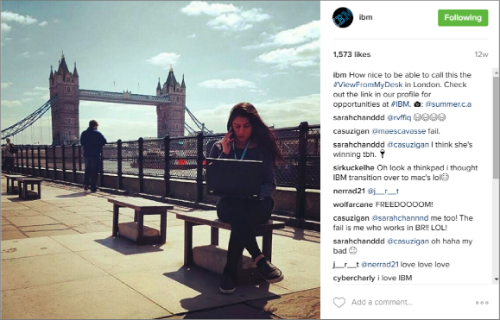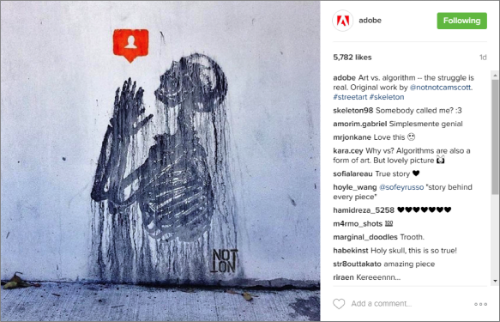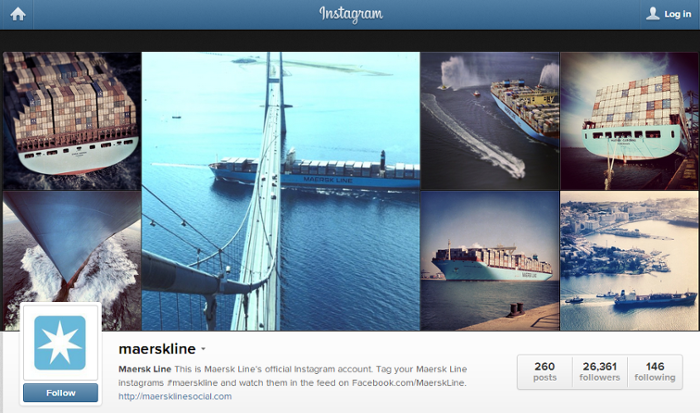How B2B Brands are Cashing In On User-Generated Content
For years now brands like GoPro, Starbucks, and Apple have made billions through user- generated content (UGC), so what's stopping you from doing the same? Oh, I know what! You may think they are all consumer brands, and B2C marketers have the upper hand in the competition game as their products/services have something “fun and exciting” to offer most of the time. Just because you don’t have a product like GoPro that users are dying to post the pictures when they purchase one doesn’t mean B2B brands can’t cash in on UGC. So the question is; how to make this kind of idea work for a B2B audience? As the old saying goes; where there’s a will, there’s a way.
generated content (UGC), so what's stopping you from doing the same? Oh, I know what! You may think they are all consumer brands, and B2C marketers have the upper hand in the competition game as their products/services have something “fun and exciting” to offer most of the time. Just because you don’t have a product like GoPro that users are dying to post the pictures when they purchase one doesn’t mean B2B brands can’t cash in on UGC. So the question is; how to make this kind of idea work for a B2B audience? As the old saying goes; where there’s a will, there’s a way.
69% of consumers say a source is trustworthy when the expert has used the product or service before, and B2B decision makers put a lot of emphasis on other professional opinions when making decisions. Most obviously, marketers would potentially be the biggest benefactors of the power of user-generated content within organizations but besides them, there are also some other groups outside of the marketing organization that UGC can far outperform professional content for them. The Human Resources department, for instance, can propel employee engagement or recruit new talents through user-generated content by building the employment brand. Customer Service, on the other hand, may need UGC in a form of video that can educate people about the product or the service. 64% of IT professionals claim UGC helped them solve problems in the workspace through experience-based advice.
Sure, some customers willingly share reviews because they are simply excited about your products, but an effective UGC strategy shouldn’t rely on the goodwill of customers alone. So, the next question is, how are we going to make our audiences feel inspired and motivated to take action? Here is some food for thought:
Creating B2B communities: Many firms have started to create forums where professionals can discuss trends and ask for advice from peers. The outcome is twofold as the firm can also discover the pain points to make improvements while engaging deeply with the audience. Salesforce, for example, has an MVP program where the members receive special previews of products and an annual event, with gifts, based on their hours of service engaging with non-MVP members. Additionally, Salesforce did this when creating a site called Idea Exchange. This site enables people to suggest new features for the company’s products and vote on their favorite ideas. The ideas with the most “likes” and comments appear at the top of the page.
Collaborate: Let’s face it; we’re all busy people so step in and work with your customers to create content where they can pass their point across with less effort. HubSpot, for instance, created real life success videos for companies that have used their marketing automation software, without making content over salesy.
Hold a contest: Contests are an effective way to make the audience feel inspired and motivated to take action. For example, in 2014, Intuit, the software provider for Canadian tax preparers to prepare and file taxes, was looking for a deeper way to engage with small business customers. Intuit knew that the one thing a small business never has enough of are resources—or, in this case, advertising budget. With that in mind, they decided to hold a contest that would help a small business make a very big splash through advertising. And not just any advertising: Intuit was going to give away a Super Bowl Ad. Brands were asked to submit a video telling their story as their entry to the contest. Thousands of companies participated, and millions voted. Integrating UGC into Intuit’s marketing created a unique marketing opportunity for both its customers and its own brand. As a result, it worked remarkably well.
Hootsuite, the social media management platform provider, also run UGC content on Instagram. The goals of the platform’s “#IWorkFromHere” UGC campaign were encouraging Hootsuite app downloads as well as engaging with their followers by enabling them to share how and where they do their social media work. The company picked and announced the winner among the participants every week. Here’s one of the winner posts:

Create a dynamic FAQ page: When we hear UGC, social media is the first channel to come to mind due to the explosion in popularity of Facebook, Instagram, Snapchat, and so on, but there are some other ways to host user-generated content, and your website is one of those. A study by Forrester discovered that as many as 72% of customers prefer to use self-help options rather than reach out to a company, as modern customers tend to be self-researchers. So they will be searching your website for more information to get answers to their questions, long before they create contact with sales or a support department. Therefore, FAQ pages are a necessary piece of content. However, there is always room for authenticity so try to go beyond a traditional FAQ page with some creative and niche ideas and design. To that point, you can always involve your customers to create that page by asking their opinion through polls, surveys etc. The page is designed for banishing their doubts, after all.
Engage with employees for UGC: It is always wise to give a glimpse into the company’s culture to build brand identity so your audience can relate more. To that point, instead of using stale stock images, take advantage of your employees’ creativity and encourage them to express the favorable part of their work life on social media. Maybe even run a small contest within the organization and offer a little incentive. It results in two birds with one stone as you can reinforce employee engagement while portraying a dynamic work environment.
Run hashtag campaigns on social media: As the name implies, it is one the best ways of socializing with your customers. Besides, your social media accounts need some level of authenticity that you can gain through content created by your audience. Not to mention how diverse an audience you can attain from those channels. After all, nearly 99% of UGC is owned by the social networks. If what you are trying to achieve is generating buzz and ownership of UGC is not a priority, hashtag campaigns are the most effective and efficient way, but a drawback is that at the end of the day, the social channel owns branded UGC, licensed and royalty-free, and the metadata, which provides a deeper level of understanding of audience, behind the UGC generated from the hashtag campaign. See how big B2B players are stepping up their games via UGC content on social media:
The image below was initially posted by an IBM employee in an attempt to show off her workday. IBM shared the photo on their Instagram account and the photo captured almost 1,600 likes:

As you know, Adobe provides the design tools and creative apps alongside other software. At the time of this article, this post had been up for just one day and already had 5,753 likes

Do you think your product is not sexy enough to generate buzz despite the power of UGC? Well, you might be wrong. Don’t take it from me, take it from the 'most exciting boring brand' General Electric. GE has created a playful, educational and informative persona on social media. One of its effective campaigns was a video collection of 'firsts'. The video below is the combination of three independent videos; Zeng's First Flight, Kumiko's First Ultrasound, and Moon Power in Scotland. The company said: "GE works on things that matter. The best people and the best technologies taking on the toughest challenges. Finding solutions in energy, health, and home, transportation, and finance. Building, powering, moving and curing the world. Not just imagining. Doing. GE works."
If you still think UGC only works for B2C the best, this story might change your mind. Maersk Line is the world's largest container shipping company with operations in more than 100 countries, well known within the shipping, energy and maritime technology industries – which also happens to be the organization that I worked for four years. In 2012, the company won the Social Media Campaign of the Year and Community Presence Award at the European Digital Communication Awards by competing with 500 other companies including even well-known B2C brands. The jury gave the following reason for awarding Maersk Line:
“At an extremely low-cost, shipping giant Maersk Line has secured an astounding 420,000 fans on Facebook and a comprehensive presence on 8 other platforms – in less than 11 months. The company’s social media program has changed the face of Maersk Line and is an example for other B2B companies to follow.”
To win the award, Maersk Line executed a different campaign for each social channel. On LinkedIn, they used the platform to have a "serious professional forum" where they can connect with customers. With Instagram and Pinterest, on the other hand, they run a continuous campaign of user-generated content of "container spotters"; followers take pictures of containers and upload them to the platforms.

To create a sense of community user-generated content (UGC) is the key. Content created by a brand is still informative, but when it’s written by peers, that content is instantly considered more trustworthy. I hope these tips and best-practices inspired and guided you. We would love to hear from you about your own UGC campaigns in the comment section below.

Venus Tamturk
Venus is the Media Reporter for CMS-Connected, with one of her tasks to write thorough articles by creating the most up-to-date and engaging content using B2B digital marketing. She enjoys increasing brand equity and conversion through the strategic use of social media channels and integrated media marketing plans.